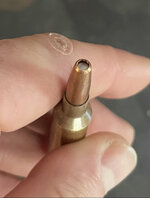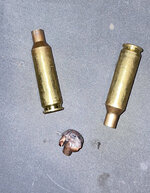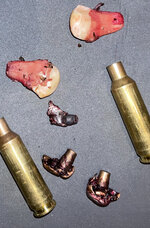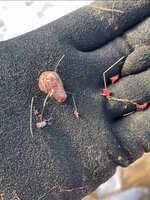Lawnboi
WKR
- Joined
- Mar 2, 2012
- Location
- North Central Wi
Can someone explain the nose ring to me? And maybe how these dtacs upset?
The principle behind the terminal purpose of it is that it creates 1. A thinned section and 2. A stress riser in the jacket of the bullet. That is in addition to the BC deviation reducing characteristics of it.Can someone explain the nose ring to me? And maybe how these dtacs upset?
I could give you the redneck run down, but I will let @Formidilosus give a more articulate answer.Can someone explain the nose ring to me? And maybe how these dtacs upset?
Can someone explain the nose ring to me? And maybe how these dtacs upset?





all bullets that rely on yawing as the mechanism for bullet upset- is variability. Not necessarily variability in “killing” or wound size created- all wounds have been very good to excellent, but in how the bullet behaves. If someone thinks that what a bullet looks like after it’s pulled out of an animal determines how well it kills, they’ll hate the DTAC NR. If, they only care how it kills, they’ll like it. A yawing bullet crushes a lot of tissue, and a rapidly fragmenting bullet creates very large wounds- they just do it differently. The DTAC is a closed nose design- there is no opening whatsoever in the tip of the bullet. The Nose Ring does two things- 1) reduces the bullets BC standard deviation; and 2) is “supposed” to create a fracture point for the tip to break off upon impact, exposing a wide open hollow point and the lead for rapid fragmentation.
This is what the bullet looks like with the tip broke off (you can see the Nosering in the pics Ryan posted)-
View attachment 539526
View attachment 539527
So ostensibly the hits point forward, the nose breaks off exposing the massive cavity, and then still point forward it fragments violently….
Well reality is funny sometimes. Sometimes it does exactly that. But, usually not. In order for the nose to break off it needs lateral pressure- I.E., sideways pressure. Pushing straight down on the nose does nothing, the moment you put any sideways angle into the pressure, the tip starts to bend/break. If we understand what things do in tissue/fluid, then it becomes obvious that in order for that tip to break off in an animal, the bullet is going to be yawing (tumbling). Even if it didn’t yaw first, the tip doesn’t come off perfectly from the front, it breaks sideways: as soon as there is drag to one side of the point forward bullet, it pulls the bullet in that direction starting the yaw, aka tumbling.
So what we have seen in some testing, and 22 or 23 animals (mostly elk) is that one of four things happens, and it’s random which ones.
1). Bullet appears to stay point forward, the nose breaks off and the bullet fragments violently. This seems to happen more with deeper nose cuts, and higher velocity impacts- 10-15%’ish of the time.
2). The bullet yaws (tumbles) 4-6 inches inside the animal, the nose breaks off, and the bullet fragments more like a Berger and other similar OTM’s. The DTAC has a thicker jacket and stays together/penetrates deeper, usually exiting elk. This seems to happen about 50% of the time.
3). The bullet yaws (tumbles) inside the animal at 4-6 inches deep, the tip breaks off but the bullet does not fragment, instead it stays together and tumbles one or two times before generally exiting.
Example of that-
View attachment 539530
4). And only seen this year with elk and 3 shots- the tip breaks off, the bullet stays point forward and expands exactly as how a bullet is “supposed” to.
Examples of that-
View attachment 539531
View attachment 539532
The key point here, is that likeallbullets that rely on yawing as the mechanism for bullet upset- is variability. Not necessarily variability in “killing” or wound size created- all wounds have been very good to excellent, but in how the bullet behaves. If someone thinks that what a bullet looks like after it’s pulled out of an animal determines how well it kills, they’ll hate the DTAC NR. If, they only care how it kills, they’ll like it. A yawing bullet crushes a lot of tissue, and a rapidly fragmenting bullet creates very large wounds- they just do it differently.
The 115gr DTAC Noserings (esp. the deeper cut ones) are my preference for elk in 6mm. IIRC 16 of 18 have exited from 60 yards to 970 yards; all have created very good wounds, and all killed quickly. Even at 1,500 something FPs impact they tumbled and preformed very well.
Thanks for the explanation.
Another question I’d have would be in what case and why would you choose this over say a Berger? They sound somewhat similar.
I prefer a tipped bullet on deer, not much elk experience. Do you generally prefer a Berger or dtac style bullet for elk sized game?

Iv got a 7 twist creedmoor I should try some dtacs in. Hopefully Sierra keeps them supplied, seems like they have been dropping the ball more than the other manufacturers.
Form,The 115gr DTAC Noserings (esp. the deeper cut ones) are my preference for elk in 6mm. IIRC 16 of 18 have exited from 60 yards to 970 yards; all have created very good wounds, and all killed quickly. Even at 1,500 something FPs impact they tumbled and preformed very well.
Form,
In reference to the deeper cut, I understand that the nose ring cut can be adjusted. My assumption is that the ones that can be ordered from DTAC are somewhere in the middle, around .030". Is it worth having a cutter and customizing that depth or are the ones on the site adequate?
As a related question, any positives/negatives to the TBN coated ones? I've research the coating and most results seem positive. Any reason not to order coated ones at the same price?
Nilgai down? How did it go?FF with this rifle. This will probably be the last hunting trip for this barrel. It will become the FF barrel at UM. Quite a few 6UM on order now.
A Nilgai will be a great test. I hope to get a good close shot in the shoulder. Hope to shoot a few hogs too.
Sent from my iPhone using Tapatalk Pro



Looks like a good opportunity for some terminal testing! I'm interested to hear your final take on the performance on the smaller critters.Works on pigs
Sent from my iPhone using Tapatalk Pro






Ryan, curious about what the “guide” or property owner thought about using a 6mm bullet on Nilgai?Lane’s Nilgai,
Shot 150 yards slightly quartered, went 20 yards.
Sent from my iPhone using Tapatalk Pro
Lets talk about what really matters.
Does anyone else keep reading it as "sixum" vs "six you emm"
We had to do some sweet talking. They want a 200-grain bullet doing 3000FPS as a minimum.Ryan, curious about what the “guide” or property owner thought about using a 6mm bullet on Nilgai?
Several of the guides for nilgai insist/recommend .30 cal magnums…
Did they learn anything?We had to do some sweet talking. They want a 200-grain bullet doing 3000FPS as a minimum.
